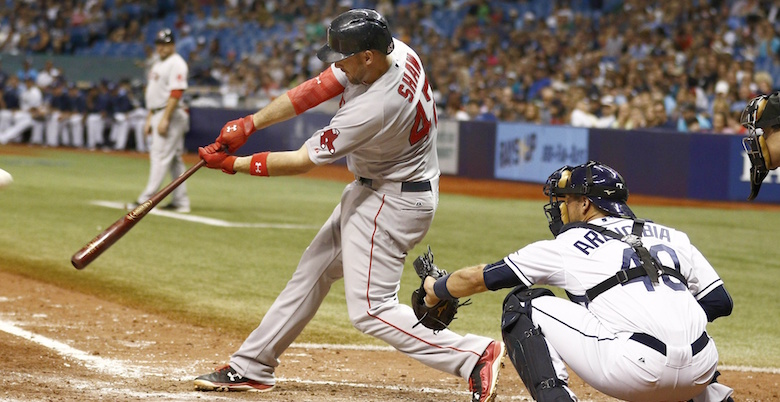Welcome to BP Boston’s Roster Recap series! Over the next four months, we’ll be breaking down every player on Boston’s 40-man roster and many of their top prospects in order to provide a comprehensive overview of the Red Sox roster’s strengths and weaknesses, as well as what we can expect moving forward. There’s no better time than the offseason to review the best (there was some best!) and worst (there was a lot of worst!) of the past year in red and navy. You can see previous editions of Roster Recap here.
When you think of the Red Sox farm system and developmental success, odds are you think of names like Xander Bogaerts, Mookie Betts and Blake Swihart. If you’ve been around for a while, maybe you also think of Dustin Pedroia, Junichi Tazawa, Jon Lester, Jacoby Ellsbury and Clay Buchholz. The point here: stars and key cogs tend to get all the recognition when we review what farm systems have yielded, and that’s especially true when said stars stem from early-round picks or major international free-agent signings.
Travis Shaw is not a star, was not a high draft pick, was not a big international signing and was never considered an elite prospect. When we think about this next generation of Bogaerts/Betts-led Red Sox teams, odds are Shaw will not play a major role in their successes or failures.
But every team needs role players who can fill in when injuries strike, excel in particular match-ups and provide depth without forcing a team to commit significant resources. That the Red Sox appear to have such a player in Shaw — a former ninth-round pick out of Kent State University — should be celebrated.
What Went Right in 2015
Pretty much absolutely everything. Shaw was posting mediocre stats in Pawtucket when he got the call to the big leagues. All he did in The Show was hit .274/.331/.491, smashing 13 homes and 10 doubles in 248 PA. He proved to be a solid defender at first base and even started five games at third base. You don’t want him there on a regular basis, but he didn’t embarrass himself, which is more than you can say for Pablo Sandoval.
But really, this is all about the bat. Shaw finished with the 21st-best TAv among first basemen with at least 200 PA. He had a higher slugging percentage than Adrian Gonzalez or Albert Pujols. He had a higher ISO than Jose Abreu or Miguel Cabrera. He was really, really good against southpaws, hitting .329/.353/.622 after struggling against same-side pitching for most of his professional career.
He did fun stuff like this:
And this:
And this:
It was a fun ride.
What Went Wrong in 2015
There are a few red flags that suggest Shaw’s 2015 performance is less than sustainable. There’s his random success against left-handed pitchers that, if we’re being honest, is probably more of a SSS mirage than indicative of a future as lefty-masher. Against right-handers, Shaw hit just .243/.319/.417, which looks a lot like his overall Triple-A line. If you’re a pessimist, you’re worried about that line serving as Shaw’s true talent level.
Shaw also struggled with some secondary offerings, hitting against the slider in 2015, hitting just .235 with a .353 SLG against them, per Brooks Baseball. He also swung and missed at nearly a quarter of changeups thrown his way.
Still, Shaw’s BABIP was reasonable (.310), his strikeout rate was acceptable (23%) and while he was a little pull-happy (39.8%) that’s not a terrible strategy for a left-hander to use in Fenway Park. Statistically, we’re all good here. Though I will say he looks a little too much like John Lackey.
Outlook for 2016
Shaw is a solid candidate to fill in for Hanley Ramirez if the latter is hurt, unproductive or some combination of the two. It’s easy to envision Shaw surpassing 200 PA once again in 2016, and while his reverse platoon split from last year make him a bit of an odd fit, odds are that trend won’t continue much into the future.
Could Shaw start for a second-division team? Maybe. But he’s probably better off as a bench bat who can man both corners, serve as a serious threat to leave the yard late in games and who won’t embarrass himself if he is pressed into temporary starting duties. Considering Shaw will do all that for the league minimum — and considering he has plenty of options left should he regress — the soon-to-be 26-year-old should enjoy several years as a relevant roster figure. For a ninth round pick, you can’t ask for much more.
Photo by Reinhold Matay/USA Today Sports Images

Very similar 1st year stat line of a much more heralded ‘prospect Will Middlebrooks. I was not alone in thinking Middlebrooks was going to be a prototypical slugging 3rd baseman for the Redsox for a long time. If Hanley proves as inept at 1st as he was in left,I would like to see Dave Dombrowski add a quality 1st baseman,but not before they give Travis Shaw a legitimate shot.